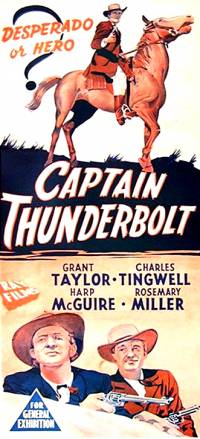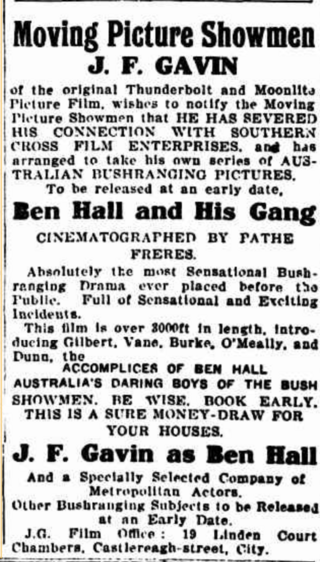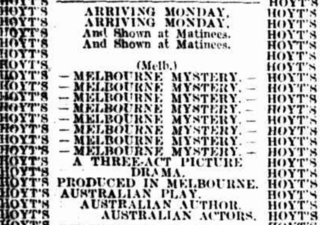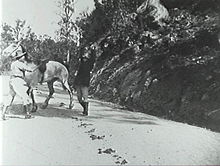
John F. Gavin was a pioneer Australian film actor and director, one of the early filmmakers of the 1910s. He is best known for making films about bushrangers such as Captain Thunderbolt, Captain Moonlite, Ben Hall and Frank Gardiner. Known informally as 'Jack', Gavin worked in collaboration with his wife Agnes, who scripted many of his films.

The Blue Mountains Mystery is a lost 1921 Australian silent film directed by Raymond Longford and co-directed by Lottie Lyell.

Captain Thunderbolt is a 1953 Australian action film from director Cecil Holmes about the bushranger Captain Thunderbolt. It was one of the few all-Australian films of the 1950s.

Moonlite is a 1910 Australian bushranger film about Captain Moonlite, played by John Gavin, who also directed for producer H.A. Forsyth. It was also known as Captain Moonlite and is considered a lost film.

Ben Hall and his Gang is a 1911 Australian film about the bushranger Ben Hall, played by John Gavin, who also directed. It is considered a lost film.
Agnes Gavin (1872–1947), was an Australian actor and screenwriter in the silent film era. She worked in collaboration with her husband John Gavin throughout her career. She wrote the majority of his films and was arguably the first specialist screenwriter in the history of the Australian film industry. In newspapers she was advertised as the "well known picture dramatizer" and was praised for creating "cleverly constructed stories". Many of her films are considered lost.

Frank Gardiner, the King of the Road is a 1911 Australian film about the bushranger Frank Gardiner, played by John Gavin, who also directed. It was the fourth consecutive bushranger biopic Gavin made, following movies about Captain Thunderbolt, Captain Moonlite and Ben Hall.

The Assigned Servant, or the Life Story of a Deported Convict is a 1911 Australian silent film about a convict who is transported to Van Diemen's Land. It was made by the husband-and-wife team of John and Agnes Gavin and is considered a lost film.

The Mark of the Lash is a 1911 Australian silent film. It is a convict-era melodrama made by the husband-and-wife team of John and Agnes Gavin.
The Drover's Sweetheart is a 1911 film from the team of Agnes and John Gavin.

The Martyrdom of Nurse Cavell is a 1916 Australian silent film starring John Gavin about the execution of nurse Edith Cavell during World War I.

A Melbourne Mystery is a 1913 Australian silent film starring John Gavin. Another title is The Unseen Hand.

Keane of Kalgoorlie, or a Story of the Sydney Cup is a 1911 Australian silent film set in the racing and gambling circles of Sydney, based on a popular play by Edward William O'Sullivan and Arthur Wright, adapted from the novel by Wright.

Sunrise is a 1926 Australian silent film co-directed by Raymond Longford, who took over during filming.
The Life and Adventures of John Vane, the Notorious Australian Bushranger is a 1910 Australian silent film about the bushranger John Vane, who was a member of Ben Hall's gang. It was the first dramatic film from Cosens Spencer who was a key producer of early Australian movies.

A Rough Passage is a 1922 Australian silent film directed by Franklyn Barrett based on the novel by Arthur Wright. It was Barrett's final feature and is considered a lost film.

Dope is a 1924 Australian silent film about a respected citizen who is blackmailed by someone from his past. It is considered a lost film.

Henry Albert ('Bert') Forsyth, known professionally as H. A. Forsyth, was a pioneer of Australian film production during the silent era. From about 1907 to 1909 Forsyth worked as a travelling picture showman, screening the film Robbery Under Arms in Australian country towns. In 1910 his company, Southern Cross Motion Pictures, produced and released two successful motion pictures, Thunderbolt and Moonlite, based on incidents in the careers of the bushrangers Frederick Ward and Andrew Scott. For these projects Forsyth worked with Jack Gavin, who directed both films and acted in the lead roles. In January 1913 the New South Wales Government banned Forsyth's bushranger films. At various stages in his career Bert Forsyth also managed theatres that screened motion pictures.
An Interrupted Divorce is a 1916 Australian short comedy film directed by John Gavin starring popular vaudeville comedian Fred Bluett.
Black Talbot is a 1911 Australian film from the Australian Film Syndicate who also made The Octoroon. It is a lost film.


















